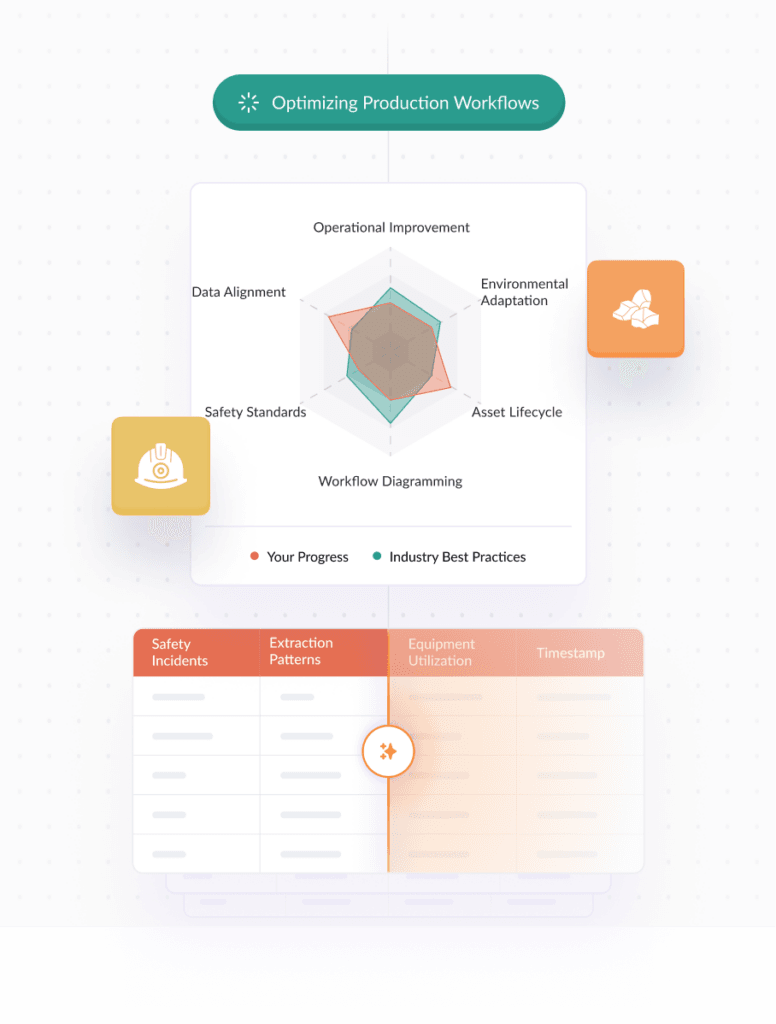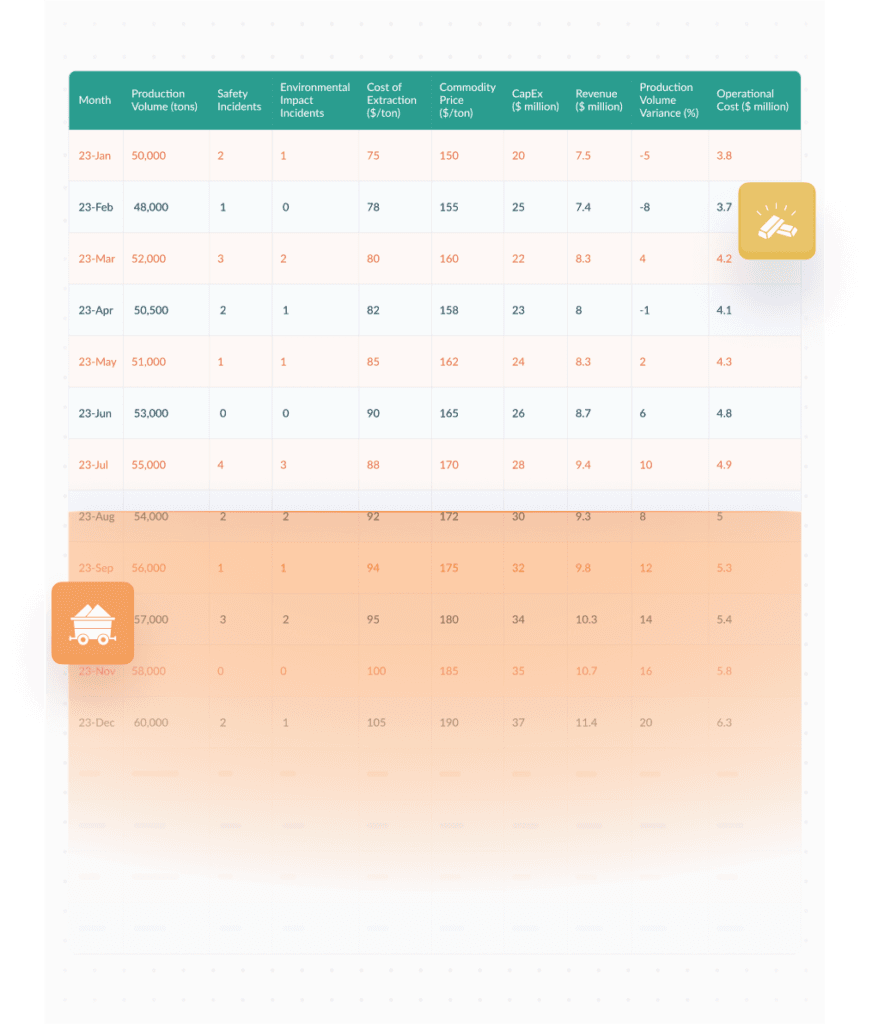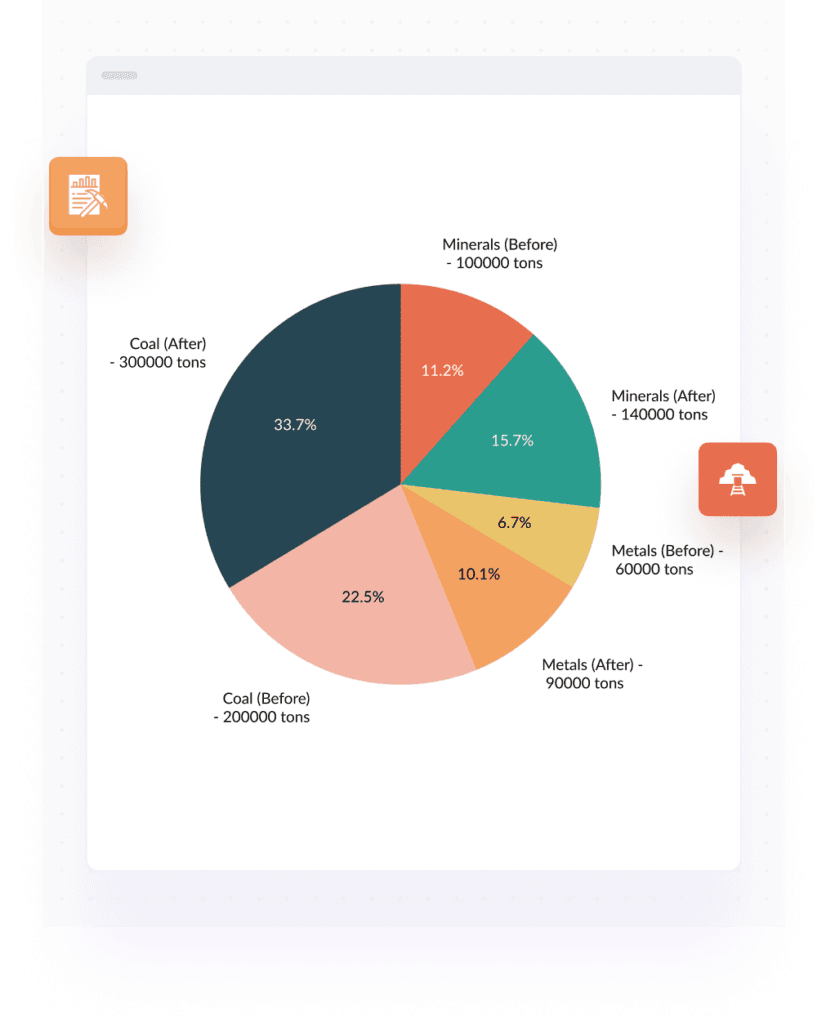Mining
Coal, Metals, Minerals, and Other Extractive Activities

Financial & Capital Analytics
Extraction Cost Analysis: Analyze the cost of extracting various minerals and metals, considering factors like ore grade, mining method, and geographical challenges. Assess how these costs impact profitability margins across different mining sites
Revenue Impact of Commodity Prices: Scrutinize the sensitivity of revenue streams to fluctuations in global commodity prices. Model the financial impact of price volatility on overall business performance
Capital Expenditure (CapEx) Efficiency: Evaluate the efficiency of capital expenditures in terms of return on investment for new mines, expansion projects, and equipment upgrades
Asset Lifecycle Management: Optimize the financial performance of mining assets throughout their lifecycle. Assess when to invest in new equipment, when to refurbish existing assets, and when to divest
Risk Diversification Strategies: Balance the portfolio of mining assets to reduce dependence on any single commodity or market. Develop strategies to hedge against price volatility and market downturns
Global Supply Chain and Demand Dynamics: Conduct market research to understand the global demand for various minerals and how supply chain dynamics influence market prices. Analyze geopolitical factors that could impact supply routes and pricing
Technological Innovation in Mining: Investigate the financial benefits and challenges of adopting new mining technologies such as automation and environmentally friendly extraction methods. Analyze the adoption rates and performance improvements associated with these technologies
Project Feasibility Models: Develop detailed financial models to assess the feasibility of new mining projects. Include projections of costs, revenues, and potential environmental impacts
Break-Even Analysis: Create models to determine the break-even points for different mining operations. Factor in variable and fixed costs to understand the volume of production needed to cover all expenses
Financing Large-Scale Mining Operations: Identify suitable financing options for large-scale mining operations, including joint ventures, debt financing, and equity funding. Consider the long-term financial impacts of these decisions
Investment Analysis and Portfolio Management: Advise on managing a portfolio of mining investments, focusing on diversification, risk management, and alignment with long-term strategic goals
Production Volume Variance: Track and analyze variances between projected and actual production volumes. Investigate underlying causes such as equipment failure, supply chain disruptions, or labor issues
Cost Control Management: Monitor variances in operational costs, including energy consumption, labor costs, and material costs. Implement strategies to control costs and increase operational efficiency
Environmental Risk Financial Impacts: Evaluate the financial implications of environmental risks associated with mining operations. Develop strategies to mitigate these risks and manage potential financial exposures
Investment Risk Analysis: Perform risk analysis on investments in mining operations, considering factors like commodity price risks and operational risks
Strategic Mergers in the Mining Sector: Analyze potential M&A opportunities to strengthen market position, acquire new technologies, or expand into new geographical areas. Evaluate synergies, cost savings, and potential integration challenges
Asset Acquisition and Divestiture: Assess the financial and strategic implications of acquiring new mining assets or divesting underperforming or non-core assets. Model the potential financial impact of these transactions
Process Mining
Record data from sensor outputs, production logs, and safety reports in the mining of coal, metals, minerals, and other materials
Harmonize this information, ensuring that it accurately reflects operational realities and is suitable for analysis
Reveal mining processes, from extraction to material handling and safety procedures, through detailed process modeling
Ensure that mining operations comply with environmental and safety standards, identifying non-conformities and potential risks
Implement improvements in operational efficiency, safety protocols, and environmental compliance using the mined data


Business Intelligence
Compile data on production volumes, safety incidents, and environmental impacts to monitor operational efficiency and compliance with regulations
Analyze breakdowns or inefficiencies in mining operations by reviewing equipment performance data, operational practices, and geological reports
Utilize sensor data and historical mining records to predict equipment failures or estimate the depletion rates of mining sites
Formulate operational adjustments or enhanced safety measures to mitigate risks and extend the lifespan of mining assets based on predictive analysis
Combine data from market demands, extraction rates, and sustainability practices to infer long-term strategic decisions for resource management and environmental stewardship
Streamlining
Map out the entire extraction and processing cycle, from exploration to ore extraction and waste management. Identify process bottlenecks or environmental impact points that need addressing
Employ automated machinery for drilling, blasting, and transporting raw materials. Use drones for site surveying and monitoring to enhance safety and efficiency
Monitor key performance indicators such as extraction volume, safety incidents, equipment uptime, and environmental compliance to evaluate operational effectiveness and safety standards
Integrate operations across different mining sites where possible, or centralize functions such as procurement and HR to optimize resource allocation and cost-efficiency
Implement standardized safety protocols, equipment maintenance schedules, and environmental compliance procedures across all mining operations to ensure consistent operational practices and reduce risks
Set up feedback systems from site managers, workers, and environmental analysts to quickly adapt operations in response to safety concerns or environmental regulations
Conduct periodic reviews to assess if streamlining efforts are achieving their goals in terms of productivity, cost reduction, and environmental sustainability. Adjust operational strategies based on these findings

